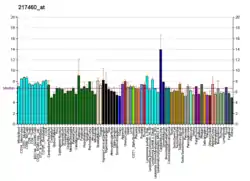| TNP2 | |||||||||||||||||||||||||||||||||||||||||||||||||||
|---|---|---|---|---|---|---|---|---|---|---|---|---|---|---|---|---|---|---|---|---|---|---|---|---|---|---|---|---|---|---|---|---|---|---|---|---|---|---|---|---|---|---|---|---|---|---|---|---|---|---|---|
| Identifiers | |||||||||||||||||||||||||||||||||||||||||||||||||||
| Aliases | TNP2, TP2, transition protein 2 (during histone to protamine replacement), transition protein 2 | ||||||||||||||||||||||||||||||||||||||||||||||||||
| External IDs | OMIM: 190232 HomoloGene: 3958 GeneCards: TNP2 | ||||||||||||||||||||||||||||||||||||||||||||||||||
| |||||||||||||||||||||||||||||||||||||||||||||||||||
| |||||||||||||||||||||||||||||||||||||||||||||||||||
| |||||||||||||||||||||||||||||||||||||||||||||||||||
| |||||||||||||||||||||||||||||||||||||||||||||||||||
| Wikidata | |||||||||||||||||||||||||||||||||||||||||||||||||||
| |||||||||||||||||||||||||||||||||||||||||||||||||||
Nuclear transition protein 2 is a protein that in humans is encoded by the TNP2 gene.[3][4][5]
References
- 1 2 3 GRCh38: Ensembl release 89: ENSG00000178279 - Ensembl, May 2017
- ↑ "Human PubMed Reference:". National Center for Biotechnology Information, U.S. National Library of Medicine.
- ↑ Engel W, Keime S, Kremling H, Hameister H, Schluter G (Nov 1992). "The genes for protamine 1 and 2 (PRM1 and PRM2) and transition protein 2 (TNP2) are closely linked in the mammalian genome". Cytogenet Cell Genet. 61 (2): 158–9. doi:10.1159/000133397. PMID 1395729.
- ↑ Baskaran R, Rao MR (Jan 1991). "Interaction of spermatid-specific protein TP2 with nucleic acids, in vitro. A comparative study with TP1". J Biol Chem. 265 (34): 21039–47. doi:10.1016/S0021-9258(17)45324-5. PMID 2250010.
- ↑ "Entrez Gene: TNP2 transition protein 2 (during histone to protamine replacement)".
Further reading
- Schlüter G, Kremling H, Engel W (1992). "The gene for human transition protein 2: nucleotide sequence, assignment to the protamine gene cluster, and evidence for its low expression". Genomics. 14 (2): 377–83. doi:10.1016/S0888-7543(05)80229-0. PMID 1385303.
- Kundu TK, Rao MR (1995). "DNA condensation by the rat spermatidal protein TP2 shows GC-rich sequence preference and is zinc dependent". Biochemistry. 34 (15): 5143–50. doi:10.1021/bi00015a027. PMID 7711033.
- Nelson JE, Krawetz SA (1995). "Characterization of a human locus in transition". J. Biol. Chem. 269 (49): 31067–73. doi:10.1016/S0021-9258(18)47391-7. PMID 7983046.
- Nelson JE, Krawetz SA (1993). "Linkage of human spermatid-specific basic nuclear protein genes. Definition and evolution of the P1-->P2-->TP2 locus". J. Biol. Chem. 268 (4): 2932–6. doi:10.1016/S0021-9258(18)53863-1. PMID 8428967.
- Kundu TK, Rao MR (1997). "Zinc dependent recognition of a human CpG island sequence by the mammalian spermatidal protein TP2". Biochemistry. 35 (49): 15626–32. doi:10.1021/bi961271i. PMID 8961924.
- Steger K, Klonisch T, Gavenis K, et al. (1999). "Expression of mRNA and protein of nucleoproteins during human spermiogenesis". Mol. Hum. Reprod. 4 (10): 939–45. doi:10.1093/molehr/4.10.939. PMID 9809674.
- Wyckoff GJ, Wang W, Wu CI (2000). "Rapid evolution of male reproductive genes in the descent of man". Nature. 403 (6767): 304–9. Bibcode:2000Natur.403..304W. doi:10.1038/35002070. PMID 10659848. S2CID 3136139.
- Strausberg RL, Feingold EA, Grouse LH, et al. (2003). "Generation and initial analysis of more than 15,000 full-length human and mouse cDNA sequences". Proc. Natl. Acad. Sci. U.S.A. 99 (26): 16899–903. Bibcode:2002PNAS...9916899M. doi:10.1073/pnas.242603899. PMC 139241. PMID 12477932.
- Wykes SM, Krawetz SA (2003). "The structural organization of sperm chromatin". J. Biol. Chem. 278 (32): 29471–7. doi:10.1074/jbc.M304545200. PMID 12775710.
- Miyagawa Y, Nishimura H, Tsujimura A, et al. (2006). "Single-nucleotide polymorphisms and mutation analyses of the TNP1 and TNP2 genes of fertile and infertile human male populations". J. Androl. 26 (6): 779–86. doi:10.2164/jandrol.05069. PMID 16291974.
- Jedrzejczak P, Kempisty B, Bryja A, et al. (2007). "Quantitative assessment of transition proteins 1, 2 spermatid-specific linker histone H1-like protein transcripts in spermatozoa from normozoospermic and asthenozoospermic men". Arch. Androl. 53 (4): 199–205. doi:10.1080/01485010701426430. PMID 17852044. S2CID 21999596.
This article is issued from Wikipedia. The text is licensed under Creative Commons - Attribution - Sharealike. Additional terms may apply for the media files.



